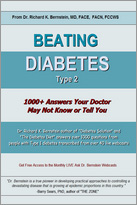Although not directly related to the normalization of blood sugars, this short but important section on foot care has been included because of the constant danger diabetes can present to the lower extremities.
The incidence of limb-threatening ulcerations in diabetics is very high, affecting approximately one in six to seven patients. Nonhealing “diabetic” ulcers are the major cause of leg, foot, and toe amputations in this country, after traumatic injuries such as those occurring in motor vehicle accidents. These ulcerations do not occur spontaneously; they are always preceded by gradual or sudden injury to the skin by some external factor. Preventing such injuries can prevent their sad consequences.
Virtually all diabetics who have experienced ongoing higher-than normal blood sugars for more than five years suffer some loss of sensitivity in their feet to pain, pressure, and temperature. This is because prolonged blood sugar elevation can injure and eventually destroy all sensory nerves in the feet (sensory neuropathy). Furthermore, the nerves that control the shape of the foot are likewise injured, with a resultant deformity that includes “claw” or “hammer” toes, high arch, and prominent heads of bones at the bases of the toes on the underside of the foot. The nerves that stimulate perspiration in the feet are also affected. This results in the classic dry, often cracked skin that we see on diabetic feet. Dry skin is both more easily damaged and slower to heal than is normal, moist skin, and cracks permit entry of infectious bacteria.
Long term elevated blood sugar also may cause impairment of circulation in the major arteries of the legs, as well as in the minor arteries and small capillary blood vessels that supply the skin of the feet. In order to heal, injured skin can require fifty times the blood flow of normal skin. If this increase in flow is unavailable, the injury will probably deteriorate, becoming gangrenous, and facilitate an infection that spreads up the leg. This infection may not respond to antibiotics. Blood circulation to the normal foot can readily increase one hundred fold, if necessary, in order to conduct the heat of warm objects away from the skin. Impaired circulation may make this impossible, and the resultant burn may not even cause pain.
A deformed foot with bony prominences (knuckles of toes, tips of toes, heels, and metatarsal heads at soles) may be continually rubbed or pressed by shoes. This foot is frequently unable to perceive the extent of such pressure and may not heal readily if injured. It can be burned at relatively low temperatures. Impaired circulation likewise can prevent the warming of cold feet so that prolonged exposure to cold can cause frostbite.
The following guidelines are therefore essential for all diabetics, to prevent foot injury and the potentially grave consequences that may ensue:
- Never walk barefoot, either indoors or out.
- Purchase shoes or sneakers late in the day, when foot size is the greatest. Shoes must be comfortable at the first wearing and should not require breaking in. Request shoes with deep, wide toe boxes. Pointed-toe shoes should not be worn, even if the tips are blunted. Some dress shoes are now available with wide, deep toe boxes. A number of currently available brands of athletic shoes and walking shoes are especially accommodating and even have removable insoles so that orthotics (see below) will fit, without making the shoe too tight. If necessary, I prescribe orthopedic or custom oxfords for certain of my patients.
- Inspect the insides of your shoes daily for foreign objects, torn lining, protruding nails, or bumps. Have them repaired if you find any of these.
- Don’t wear sandals with thongs between the toes.
- Try to alternate at least two different pairs of shoes every few days.
- Ideally, your feet should be examined daily for possible injury or signs of excessive rubbing or pressure from shoes—blisters, cracks or other openings in the skin, pink spots, or calluses. Be sure to check between your toes. Inspect your soles. If necessary, use a mirror or ask another person to check them. Contact your physician immediately if any of these signs are found.
- If the skin of your feet is dry, lubricate the entire foot. Suitable lubricants include olive oil, any vegetable oil, vitamin E oil, emu oil, mink oil, and emulsified lanolin. Many oils and lotions that contain these products as major ingredients are available commercially. Do not use petroleum jelly (Vaseline), mineral oil, or baby oil, as they are not absorbed by the skin.
- Do not smoke cigarettes. Nicotine can cause closure of the valves that permit blood to enter the small vessels that nourish the skin.
- Keep feet away from heat. Therefore no heating pads, hot water bottles, or electric blankets. Do not place feet near sources of warmth such as radiators or fireplaces. Baths and showers should feel cool—not even lukewarm. Temperature should be estimated with your hand or a bath thermometer, not with your feet. Water temperature should be less than 92°F, as even this temperature can cause burns when circulation is impaired. A bath thermometer is suggested.
- Wear warm socks and shoes of adequate size when outside in cold weather. It is wise for all diabetics to have the circulation in their feet measured every few years. If circulation is impaired, do not remain in the cold for more than twenty minutes at a time.
- Do not soak your feet in water for more than 3–4 minutes, even if so instructed by a physician. This causes macerated skin, which breaks down more easily and doesn’t heal well. When bathing or showering, get in, get washed, and get out. Don’t soak. Beware of rain, swimming pools, and any environment that may wet your feet or your shoes. If you swim regularly for exercise, before getting in the water, rub petroleum jelly (Vaseline) on your feet to protect them from the water. After leaving the water, remove the petroleum jelly with a towel.
- Do not put adhesive tape or other adhesive products like corn plasters in contact with your feet. Fragile skin might be peeled off when the tape is removed. When applying a bandage, tape should not be applied to the skin, but to the bandage only.
- Do not put any medications in contact with your skin that are not prescribed by your physician. Many over-the-counter medications, such as iodine, salicylic acid, and corn-removal agents, are dangerous. Iodine products or hydrogen peroxide should never be applied to wounds even if so directed by a physician.
- If the skin of your feet is dry, your cardiologist should try to avoid medicines called beta blockers for hypertension or heart disease, as these can inhibit perspiration that moistens the feet.
- Do not attempt to file down, remove, or shave calluses or corns. This is dangerous. The toughened skin of a callus is the body’s way of protecting against irritation, such as by a shoe that rubs your foot. Filing it off removes that protection, and in my experience, this is the most common initial cause of foot ulcers and resultant amputations. Do not permit podiatrists, pedicurists, or anyone else to do so. If calluses are present, show them to your physician. Ask her or a podiatrist to arrange for your shoes to be stretched, prescribe special shoes, or prescribe orthotic inserts. Your physician may instruct you in the use of a shoe stretcher or a “ball and ring,” both of which can be ordered by a shoe repair shop. By eliminating the pressure on your foot, the callus should resolve over time.
- Do not trim your toenails if you cannot see them clearly. Ask a friend or relative, podiatrist, or your physician to do this for you. If the corners of your nails are pointed, you can file them with an emery board or have someone else trim them.
- If you have thickened toenails, ask your physician to have clippings tested for fungal infection. If infection is present, he should prescribe Tincture of Fungoid. This solution must be applied twice daily to the nails to be effective. It must be used for about twelve months to effect a cure. It helps to first have thickened nails ground down by a podiatrist, but she/he must be very careful not to damage skin or nail bed.
- Don’t wear stockings or socks with elastic bands that are tight enough to cause visible depressions in the skin. Don’t use garters. Don’t wear socks with holes or that have been darned, have thick seams, or are so large that they bunch up.
- Phone your physician immediately if you experience any injury to your foot. I consider even a minor foot injury to be an emergency. Procrastination can be disastrous.
Put a copy of these instructions in your tickler file so that you can reread them every few months. Eventually, you should know them by heart.




